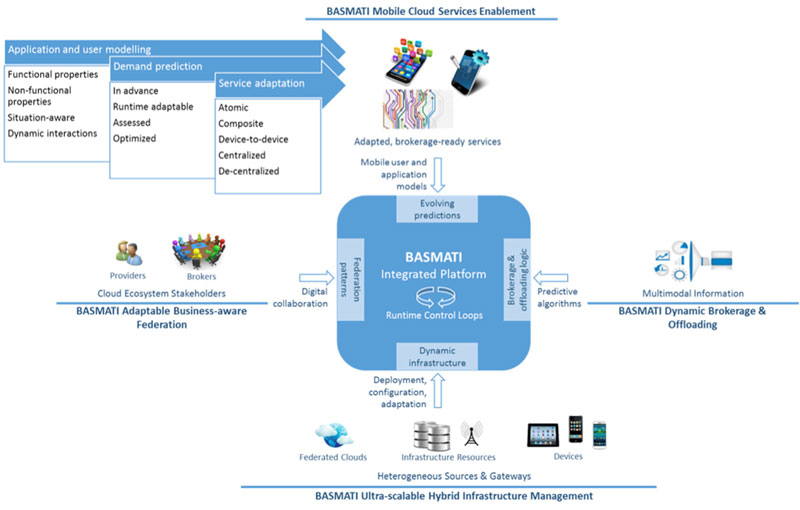by Patrizio Dazzi (ISTI-CNR)
Cloud Computing and mobile applications are key drivers for innovation. However, mobile device limitations still hinder today’s mobile applications from reaching their full potential. The joint South-Korea and EU Horizon 2020 project BASMATI is developing an integrated brokerage platform that targets federated clouds and supports the dynamic needs of mobile applications and users.
Computational clouds and mobile applications have been two of the most relevant drivers of innovation in the last decade. The combination of their particular features has fostered the development of more and more pervasive services with fast roll-out and great scalability, and with low costs for initial assets, thus strengthening industrial competitiveness and promoting economic growth. However, current technological and social landscapes are now calling for a shift towards the introduction of a more flexible, hybrid computing paradigm. Cloud platforms need dynamic, automatic management mechanisms to enable service migration and scalability that is sufficiently efficient and autonomous to cope with the requirements of very large mobile applications serving a mass of nomadic users.
The BASMATI project [L1] aims at providing a fully featured ecosystem able to integrate widely deployed cloud federations along with a range of smaller computing devices, including mobile devices, targeting crowds of users that access their data and applications while moving across national borders. BASMATI will deal with computational and storage resources localized at the edge of the network, addressing challenges related to resource heterogeneity, ultra-scalable provisioning, computation offloading, context- and situation identification, quality of service and privacy / security guarantees.
To achieve these objectives, BASMATI aims at the delivery of an integrated brokerage platform targeting federated clouds with heterogeneous resources and supporting the efficient, cost-effective execution of mobile cloud applications, in a transparent and ubiquitous manner. The design of the BASMATI platform focuses on four main axes: (i) enabling of mobile cloud services, (ii) federation of cloud infrastructures, (iii) scalable infrastructure management, and (iv) brokerage and offloading.
With respect to service enablement, BASMATI plans to support and model user mobility patterns and behaviour, and classify mobile applications in terms of their different static and dynamic characteristics (e.g., structural topology, resource access patterns, performance issues and bottlenecks, to name but a few). Furthermore, BASMATI will study functional and non-functional properties that provide (some degree of) a-priori knowledge of the resource demands, interactions between atomic service components of applications and the situational/contextual aspects that provide additional insight to the mobile user and application space.
The second axis focuses on the cloud federation. The BASMATI infrastructure will blend together existing and new technological solutions into a platform that can spread globally and leverage information from many sources, including complex resource management and business aspects, as well as user and application modeling.
The goal of the third main axis is to facilitate the development of a dynamic infrastructure consisting of different, heterogeneous resources like clouds, data and networking resources, and other kinds of edge devices. Deployment and configuration patterns will be dynamic according to the emerging requirements of mobile cloud applications and users.
The fourth axis focuses on dynamic and automated brokerage and offloading, implementing innovative algorithms (e.g., economic models and machine-learning based solutions). The ultimate aim is to leverage the information from the models to build advanced management algorithms that can drive the efficient exploitation of the Basmati infrastructure despite the many constraints: resource heterogeneity and location, user QoS requirements, user dynamicity and geographic dispersion.

Figure 1: BASMATI platform architecture.
BASMATI is designed to support both existing and new applications, with a focus on three real-world use cases: (1) Large events management, in which BASMATI will support the management of dynamic information about the event (including user-generated items) in a time- and context-aware fashion; (2) Virtual Mobile Desktop for highly nomadic users, enabling seamless and efficient access to the user environment by reacting to the different conditions occurring when users cross national and international borders; (3) Trip building [L2] of personalized time-budgeted tours of cities, with dynamic definition and detection of points of interests, users communities and visit trajectories, as well as context-aware and personalized pathways to enhance the user experience. The validation of the entire BASMATI platform is planned during the 2018 edition of Das Fest [L3], a music festival that expects more than 250.000 participants over three days.
BASMATI was launched on 1 June, 2016. The project consortium is composed of five European and three Korean partners. On the European side, the project members are: the National Technical University of Athens (NTUA), the overall project coordinator; the National Research Council of Italy (CNR), the scientific and technical coordinator; ATOS Barcelona, CAS Software AG and Amenesik. On the Korean side, the participants are: the Electronics and Telecommunications Research Institute (ETRI), serving as coordinator; Seoul National University and Innogrid.
Links:
[L1] http://www.basmati.cloud
[L2] http://tripbuilder.isti.cnr.it/
[L3] http://www.dasfest.de
Please contact:
Patrizio Dazzi, BASMATI scientific coordinator
ISTI-CNR, Italy











